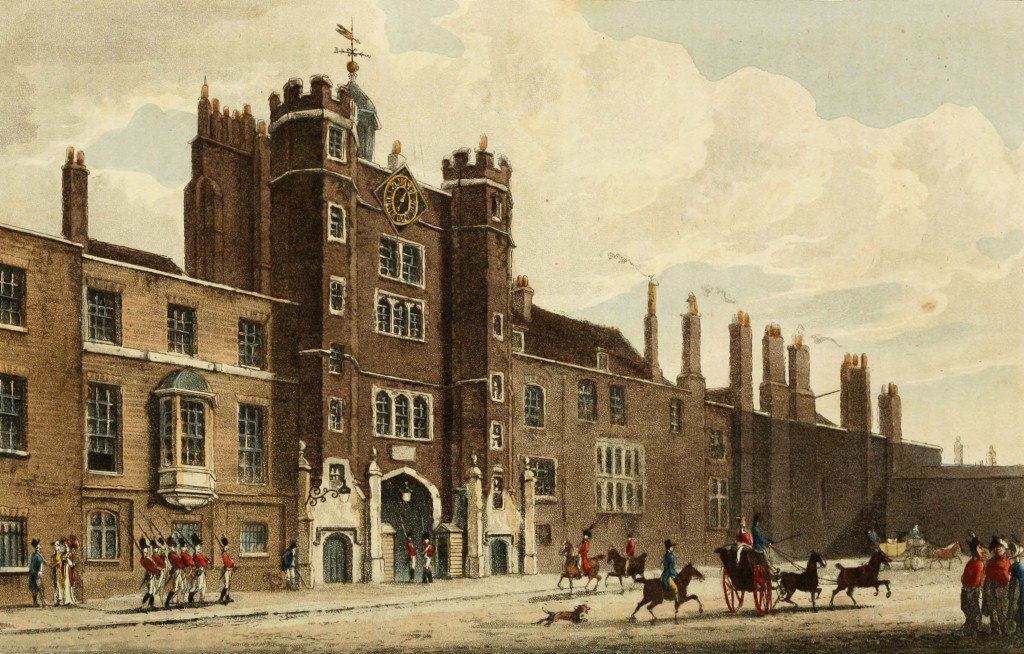Streets of London – St. James Palace circa 1812

St. James Palace, London circa 1812
from The Repository of arts, literature, commerce, manufactures, fashions and politics
‘On the site of St. James Palace originally stood an hospital dedicated to St. James, founded before the Norman conquest, by some devout citizens of London, for leprous females, and endowed with several manors in Hampstead, Hendon, and other parishes. To this foundation were afterwards added eight brethren, for the performance of divine service. This hospital was rebuilt in the reign of Henry III and the custody of it was given by Henry VI to Eton College. At the time of its surrender to the crown under Henry VIII, its annual revenues were estimated at £100. That monarch demolished the old fabric, and on its site erected a palace, which is called by Stow “a goodly manor;” but does not appear to have been the residence of royalty till the destruction of Whitehall Palace by fire in 1697.’
‘The building, of which some remains may still be discovered, especially in the north gate-way, with its towers, represented in the annexed view, was given by James I to his son Henry, Prince of Wales, who resided in it till his death in 1612. Here the unfortunate Charles I was confined on his removal from Windsor during the last eleven days of his life. In 1688, when Prince of Orange had approached very near to the metropolis, […] James II sent a message to him, offering this palace for his habitation. The offer was accepted, but at the same time intimation was given to the king that his future residence at Whitehall would be dangerous. James took the hint, and quitted for ever the palace of his ancestors. The fidelity manifested on this occasion by and old and faithful servant of the dethroned monarch, is worthy of notice.’
‘At this period it was customary to mount guard both at Whitehall and St. James’s, and Lord Craven was on duty at the latter, when the Dutch guards, by William’s orders, marched through the Park to relieve him. His lordship resolutely refused to quit his post, and was preparing to make the most determined resistance to the intrusion of the Dutchmen, when he received a command from James to submit, on which he reluctantly withdrew his party, and marched away with sullen dignity. The son of James II styled the Pretender, was born in the antichamber to the levee-room, which is still called the old bed-chamber. “The bed” observes Pennant, “stood close to the door of the back-stairs, which descended to an inner court.’
‘It certainly was very convenient to carry on any secret design, and might favour the silly warming-pan story, had not the bed been surrounded by twenty of the privy-council, four other men of rank, twenty ladies, besides pages and other attendants. James, with impudent pride, neglected to disprove the tale; it was adopted by party, and firmly believed by its zealots.”’
‘In King William’s reign St. James’s was filled up for the princess, afterwards Queen Anne, and her consort Prince George of Denmark, till Buckingham House was purchased by the queen, to be the residence of the British monarchs, but of late years has been used only for purpose of state. On the 21st of January, 1809, great part of this palace was consumed by an accidental fire, which reduced to ashes the whole south-east corner, comprehending the Queen’s private apartments, those of the Duke of Cambridge, some of the state apartments, together with the French and Dutch chapels. Since that event St. James’s has seldom been visited by royal family; and from the commencement of his Majesty’s present indisposition it has been completely deserted.’ The Repository of arts, literature, commerce, manufactures, fashions and politics, 1812.
